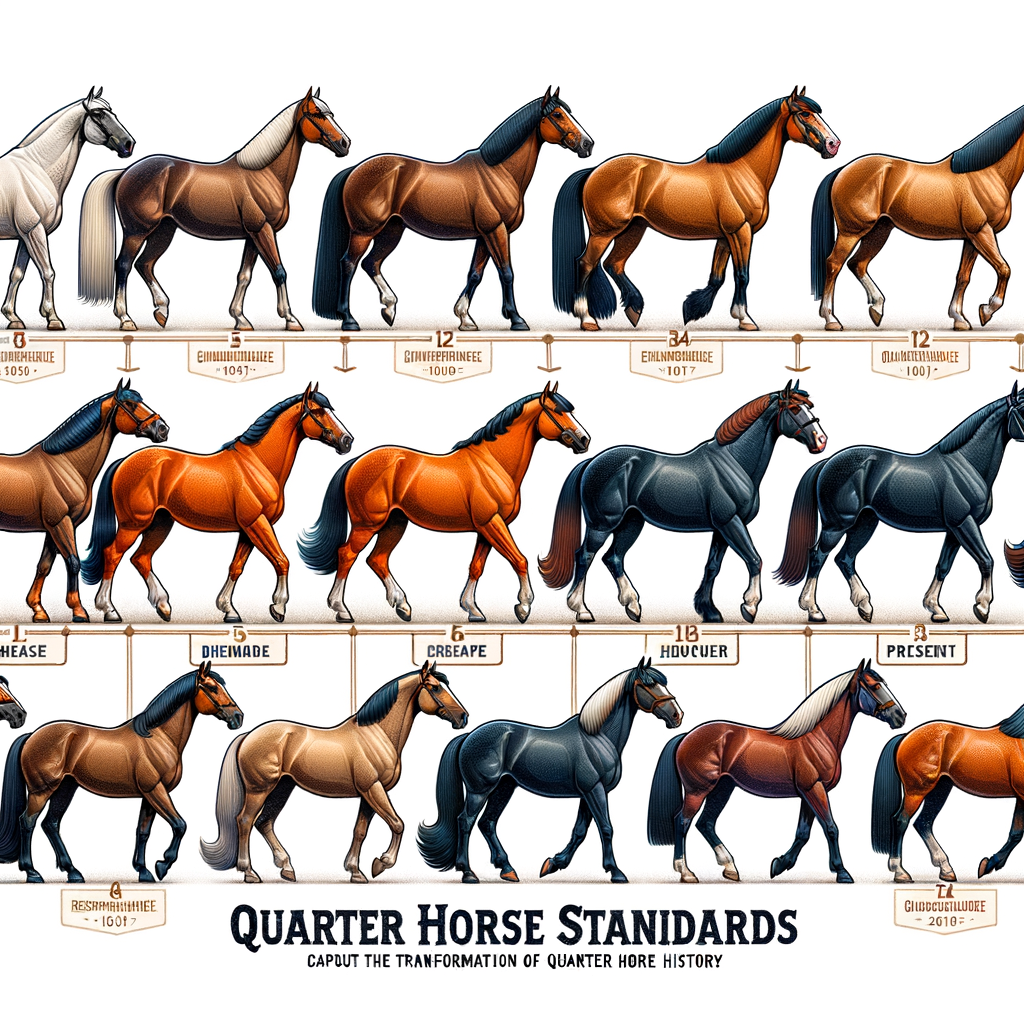
Introduction to Quarter Horse History
The Quarter Horse, known for its speed and agility, has a rich history that is as fascinating as the breed itself. Let’s delve into the origins and significant milestones of this remarkable breed.
- Origins of the Quarter Horse breed
- Significant milestones in Quarter Horse history
- 1940: The American Quarter Horse Association (AQHA) was established. This organization played a crucial role in promoting the breed and setting breed standards.
- 1960: The AQHA started its own registry, which today is the largest breed registry in the world.
- 1974: The Quarter Horse became the first breed to have its own dedicated museum, the American Quarter Horse Hall of Fame & Museum, located in Amarillo, Texas.
- 2010: The AQHA reached a milestone of registering its five millionth horse.
The Quarter Horse breed traces its roots back to the 1600s, in colonial America. The breed was developed by crossing English Thoroughbreds with native horses of Spanish origin. The result was a compact, muscular horse that was quick off the mark and could outrun any other breed in a quarter-mile race, hence the name ‘Quarter Horse’.
The Quarter Horse has had several significant milestones in its history. Here are a few:
From its humble beginnings in colonial America to its current status as one of the most popular horse breeds in the world, the Quarter Horse has a history that is as impressive as the breed itself. As we continue to explore the evolution and standards of the Quarter Horse, we will gain a deeper appreciation for this remarkable breed.
Evolution of Quarter Horse: A Detailed Analysis
The Quarter Horse, a breed renowned for its speed and agility, has a rich history that spans centuries. This section will delve into the evolution of the Quarter Horse, focusing on the standards of the past and how they have shaped the breed we know today.
Past Quarter Horse Standards
Understanding the past standards of the Quarter Horse breed provides a foundation for appreciating its current form. Let’s explore the historical physical characteristics and the roles these horses played in the past.
- Historical physical characteristics and traits
- Role and usage of Quarter Horses in the past
The Quarter Horse of the past was a medium-sized breed, typically standing between 14 and 15 hands high. They were known for their muscular build, particularly in the hindquarters, which contributed to their exceptional speed over short distances. Their coat colors varied, but the most common were chestnut, bay, and black. The Quarter Horse was also recognized for its calm demeanor and intelligence.
Quarter Horses were highly valued in the past for their versatility. They were used in a variety of roles, from farming and cattle herding to transportation and racing. Their speed made them a popular choice for short-distance races, earning them the name ‘Quarter Horse’ as they could outpace other breeds in races of a quarter mile or less. Additionally, their strength and intelligence made them excellent work horses on farms and ranches.
These past standards set the stage for the Quarter Horse’s evolution, shaping the breed into the versatile and beloved horse we know today. The following sections will delve into the current standards and the changes that have occurred over time.
Present Quarter Horse Standards
Let’s delve into the present standards of the Quarter Horse breed. We will explore their current physical characteristics and traits, as well as their modern roles and uses.
- Current Physical Characteristics and Traits
The Quarter Horse breed is renowned for its muscular build, compact body, and remarkable speed. These horses typically stand between 14 and 16 hands high (56 to 64 inches) and weigh between 950 and 1,200 pounds. They possess a broad chest and powerful, rounded hindquarters, which contribute to their exceptional speed and agility.
Quarter Horses have a well-defined and chiseled head, with a straight profile and wide forehead. Their eyes are large and expressive, and their ears are medium-sized and alert. Their coats come in a variety of colors, including chestnut, black, brown, bay, gray, palomino, and more.
These horses are known for their intelligence, versatility, and docile temperament, making them suitable for a range of equestrian activities.
- Modern Roles and Uses of Quarter Horses
Today, Quarter Horses are used in a wide array of activities. They excel in rodeo events, including barrel racing, calf roping, and team penning, thanks to their speed, agility, and cow sense. They are also popular in horse shows, performing in western pleasure, trail, and hunter under saddle classes.
Quarter Horses are also used in racing, where they can outperform other breeds in short-distance sprints. Their speed and power make them ideal for this sport. Furthermore, their calm and friendly nature makes them excellent choices for recreational riding and therapeutic riding programs.
In addition to these roles, Quarter Horses are also used in ranch work, including herding cattle. Their intelligence, agility, and ability to make quick, sharp turns make them invaluable in this setting.
In conclusion, the Quarter Horse breed has evolved over time to become one of the most versatile and popular horse breeds in the world. Their physical characteristics and roles have changed, but their strength, speed, and friendly nature have remained constant.
Changes in Quarter Horse Standards Over Time
Over the years, the standards for Quarter Horses have evolved significantly. These changes have not only affected the physical and performance standards of the breed but have also had a profound impact on the breed as a whole. Let’s delve into these changes and their implications.
- Changes in Physical Standards
- Changes in Performance Standards
- Impact of these Changes on the Breed
The physical standards of Quarter Horses have seen considerable changes. Initially, these horses were smaller, with a compact body suitable for short-distance sprinting. However, as time passed, breeders started favoring larger, more muscular horses. This shift was primarily due to the increasing demand for horses in rodeos and horse shows.
Today’s Quarter Horses stand at an average height of 15 hands (60 inches) and weigh between 950 to 1,200 pounds. They are known for their broad chest, powerful hindquarters, and short, sturdy legs.
Along with physical changes, the performance standards of Quarter Horses have also evolved. Initially, these horses were bred for their speed over short distances, earning them the name ‘Quarter Horse’. However, as the breed’s roles expanded to include work in ranches, rodeos, and shows, the performance standards diversified.
Today, Quarter Horses are evaluated on various factors such as speed, agility, endurance, and their ability to perform tasks like cutting, reining, and roping. These changes in performance standards reflect the versatility of the breed.
The changes in physical and performance standards have had a significant impact on the Quarter Horse breed. The increased size and muscle mass have made them more versatile, capable of performing a wide range of tasks. However, it has also led to some health issues like navicular disease and polysaccharide storage myopathy.
On the performance front, the diversification of standards has opened up new opportunities for Quarter Horses. They are now seen in various equestrian disciplines, from racing and rodeo events to dressage and show jumping. However, it has also increased the pressure on these horses, leading to concerns about their welfare.
In conclusion, while the changes in Quarter Horse standards have brought about many positive developments, they have also posed some challenges. It’s crucial to strike a balance between maintaining the breed’s versatility and ensuring its health and welfare.
Quarter Horse Breed Evolution: Case Studies
Let’s delve into some specific examples to better understand the evolution of the Quarter Horse breed. We’ll start with a look at how racing has influenced the breed’s standards.
Case Study 1: The Impact of Racing on Quarter Horse Standards
The world of horse racing has had a significant impact on the Quarter Horse breed. The need for speed and agility in racing has shaped the breed’s evolution in many ways.
- How racing influenced the breed’s evolution: The Quarter Horse breed is known for its speed, especially in short distance races. This is no accident. Breeders have long selected horses with the best speed and agility for breeding, aiming to produce offspring that can excel in racing. This selective breeding has resulted in a breed that is compact, muscular, and incredibly fast. In fact, the Quarter Horse is named for its ability to outrun other breeds in races of a quarter mile or less.
- Examples of notable racing Quarter Horses: There are many examples of Quarter Horses that have made their mark in racing. One such horse is Easy Jet, a World Champion Quarter Horse racehorse. Another is Dash For Cash, who won many races in his career and went on to sire many successful offspring. These horses and others like them exemplify the speed and agility that the breed is known for.
As we can see, the world of racing has had a profound impact on the Quarter Horse breed. The need for speed has driven breeders to select for certain traits, shaping the breed into the fast, agile horse we know today.
Case Study 2: The Influence of Farming on Quarter Horse Standards
The Quarter Horse, known for its agility and speed, has been significantly shaped by the farming industry. This case study will explore the role of farming in the development of the Quarter Horse breed and provide examples of these horses in a farming setting.
- Role of farming in shaping the breed
- Examples of Quarter Horses in farming
Farming has played a substantial role in shaping the Quarter Horse breed. Farmers needed sturdy, versatile horses that could work long hours in the fields, pull heavy loads, and also serve as a means of transportation. This need led to the development of the Quarter Horse, a breed known for its strength, endurance, and versatility.
Over time, the breed’s physical characteristics evolved to meet these demands. Quarter Horses developed a muscular build, a broad chest, and powerful hindquarters, enabling them to perform heavy farm work efficiently. Their compact size and agility also made them ideal for herding cattle, a common task on many farms.
Moreover, the breed’s temperament was also influenced by farming. Quarter Horses are known for their calm and steady nature, traits that were highly valued in a farm setting. These horses needed to be reliable and easy to handle, as they were often worked by children and inexperienced riders.
There are countless examples of Quarter Horses excelling in farming environments. One notable example is the story of “Old Blue,” a Quarter Horse that worked on a Texas ranch in the early 1900s. Old Blue was known for his exceptional cattle herding abilities, and his story is often cited as an example of the breed’s versatility and work ethic.
Today, Quarter Horses continue to be a popular choice for farmers and ranchers. They are used for a variety of tasks, including plowing fields, pulling carts, and herding livestock. Their strength, endurance, and calm temperament make them well-suited to the demands of farm life.
In conclusion, farming has had a significant influence on the Quarter Horse breed. The physical characteristics and temperament of these horses have been shaped by the demands of farm work, resulting in a breed that is strong, versatile, and reliable. The Quarter Horse’s role in farming is a testament to the breed’s adaptability and resilience, qualities that continue to be valued today.
History of Quarter Horse Standards: Key Takeaways
As we delve into the history of Quarter Horse standards, there are several key points that we need to understand. These points not only highlight the importance of understanding breed standards, but also how these standards reflect societal needs and preferences, and what we might expect for the future of Quarter Horse standards.
- The Importance of Understanding Breed Standards
- How Standards Reflect Societal Needs and Preferences
- Future Predictions for Quarter Horse Standards
Breed standards are crucial in maintaining the integrity and quality of a breed. For Quarter Horses, these standards have been carefully developed over centuries, with a focus on the horse’s physical attributes, temperament, and abilities. Understanding these standards is essential for breeders, judges, and enthusiasts alike, as it allows them to make informed decisions and assessments about the horses.
Over time, the standards for Quarter Horses have evolved to reflect the changing needs and preferences of society. Initially, these horses were bred for their speed and agility, which made them ideal for cattle herding and transportation. However, as society shifted towards more leisure activities, the standards changed to favor horses with calm temperaments and versatile abilities, suitable for riding and show events. This evolution of standards highlights how societal needs and preferences can shape the characteristics of a breed.
Looking ahead, it’s difficult to predict with certainty how the standards for Quarter Horses may change. However, based on current trends, it’s likely that versatility and adaptability will continue to be highly valued. As equestrian sports and activities continue to evolve, so too will the standards for the horses that participate in them. This means that breeders will need to stay informed and adaptable, ensuring that their horses meet the changing standards and expectations of the equestrian community.
In conclusion, the history of Quarter Horse standards provides valuable insights into the breed’s evolution and the factors that have shaped it. By understanding these standards, we can appreciate the breed’s unique qualities and contribute to its future development.
Conclusion: Quarter Horse Standards Evolution
As we draw the curtain on our exploration of the Quarter Horse breed standards, let’s take a moment to reflect on the journey we’ve taken. We’ve delved into the rich history of the breed, examined the evolution of its standards, and looked at how these changes have shaped the Quarter Horse we know today.
- Recap of the Quarter Horse breed standards history
The Quarter Horse breed has a storied history that dates back to the 1600s. It began as a versatile breed, valued for its speed, endurance, and adaptability. Over the centuries, the breed standards have evolved, reflecting changes in society’s needs and preferences. The breed’s physical characteristics have been refined, with a greater emphasis on muscularity, compactness, and a calm, steady temperament. This evolution has been guided by the American Quarter Horse Association (AQHA), which has played a pivotal role in defining and upholding the breed standards.
- The significance of this evolution for the breed’s future
The evolution of the Quarter Horse breed standards is not just a historical curiosity. It has profound implications for the breed’s future. As the standards evolve, so does the breed, adapting to the changing needs and preferences of horse enthusiasts. The emphasis on certain traits, such as speed and agility, has led to the Quarter Horse’s dominance in certain equestrian sports. At the same time, the breed’s versatility and good nature have made it a favorite for recreational riding and therapy work.
As we look to the future, it’s clear that the Quarter Horse will continue to evolve, shaped by the ever-changing landscape of the equestrian world. But one thing is certain: the Quarter Horse’s rich history and enduring appeal will ensure its place in the hearts of horse lovers for generations to come.









